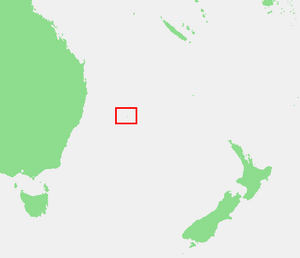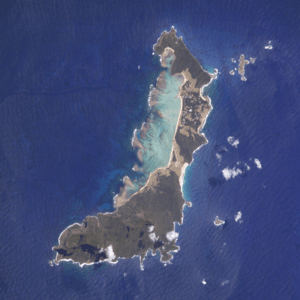Lord Howe long-eared bat facts for kids
Quick facts for kids Lord Howe long-eared bat |
|
|---|---|
| Conservation status | |
| Scientific classification | |
 |
|
| Location of Lord Howe Island |
The Lord Howe long-eared bat (Nyctophilus howensis) was a type of bat called a vespertilionid bat. We only know about it from one skull found on Lord Howe Island in 1972. This bat was an insect-eater, meaning it ate insects. It looked a bit like other long-eared bats from the Nyctophilus group, but it had a head that was quite large and long.
We don't know much about this bat. People might have seen it flying in the 1900s, but it probably died out after people discovered and settled on the island. The Lord Howe long-eared bat likely disappeared because of rats that came from shipwrecks and owls that were brought in to control those rats.
About the Bat's Name
The scientist John McKean officially named this bat in 1975. He said it was a new species in the Nyctophilus group.
The only part of the bat ever found is an incomplete skull. It's called the holotype, which is the single specimen used to describe a new species. A scientist named G. F. van Tets found it on a ledge inside a cave. The cave is called Gooseberry Cave and is located at the northern end of Lord Howe Island. The skull was probably carried into the cave by an owl.
People also call this bat the Lord Howe island bat. Its scientific name, howensis, means 'inhabiting that place', referring to Lord Howe Island. The island itself is named after Richard Howe.
What the Bat Looked Like
This bat was a vespertilionid bat, similar to other 'large-eared' bats. Based on its skull, it had a large head and body. Its palate (the roof of its mouth) was longer than its rows of teeth, and its head was long and narrow. Scientists guess its forearm was about 50 millimeters long, and it might have weighed around 20 grams.
The only skull found is almost complete, but it's missing some teeth. It's also longer than the skulls of other large Nyctophilus species. From the side, its skull looked flatter than others in its group. Because only a skull was found, it's hard to know for sure if the Lord Howe long-eared bat actually had large ears or other special face features like a nose-leaf.
Where and How it Lived
We don't have much information about how this bat lived or its habits. Scientists believe its life was similar to other bats in its family. The skull was found in a cave, and it seemed to be a fairly recent deposit, suggesting the bat disappeared not long ago.
Lord Howe Island is a small island about 600 kilometers east of Australia. It's what's left of an old volcano and has unique plants and animals. Many of its species are found nowhere else. Scientists think the Lord Howe long-eared bat came from bats that were blown over from Australia by the wind.
This bat was an insect-eating flying mammal living on an island. It had no known threats until rats and owls were brought to the island. Brown rats arrived on Lord Howe Island in 1918 when a ship called the Makambo wrecked. These rats ate the fruit of the kentia palms, which were grown for export. They probably also bothered the bats in their daytime resting spots. It's thought that the rats might have even eaten the bats.
To control the rats, Australian officials brought in masked and barn owls. While these owls are good at catching rats, they are also known to hunt slower-flying bats like the Nyctophilus bats. Another bat, the large forest bat (Vespadelus darlingtoni), still lives on the island.
The Lord Howe long-eared bat is believed to be extinct. If it's still alive, it would be critically endangered. The Alliance for Zero Extinction lists it as being in danger of disappearing very soon. To help, people have tried to get rid of the owls that were brought to the island. However, searches for the bat since 1999 have not found any. There have been a few unofficial reports of a larger, unknown bat on the island, but these sightings are not strong proof that the Lord Howe long-eared bat is still around.
See also
 In Spanish: Nyctophilus howensis para niños
In Spanish: Nyctophilus howensis para niños




